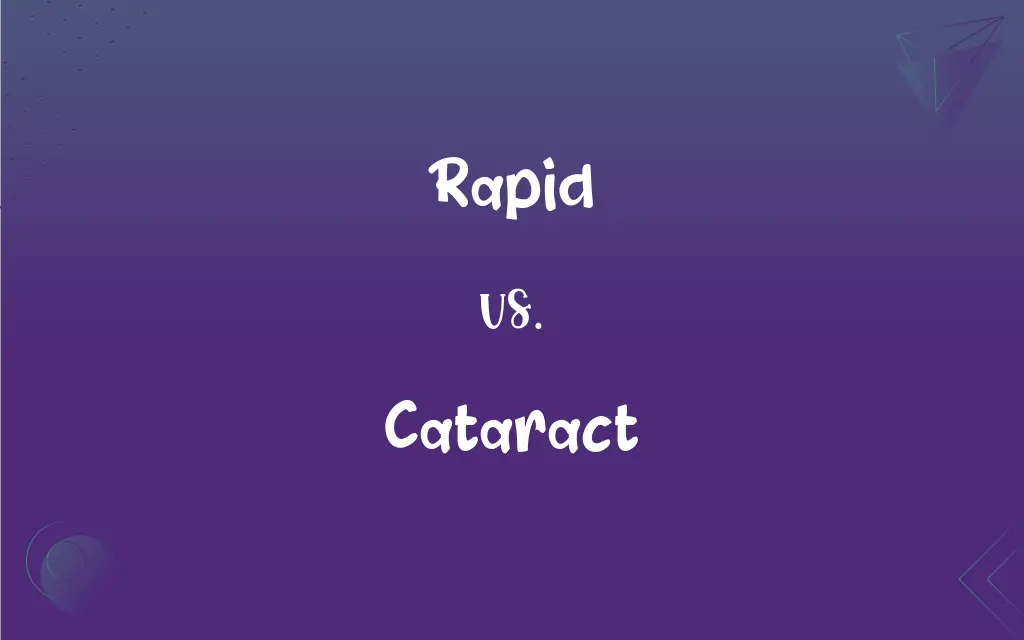Rapid vs. Cataract: What's the Difference?
Edited by Aimie Carlson || By Janet White || Updated on February 9, 2024
Rapids are fast-flowing sections of a river, while cataracts are large, powerful waterfalls or rapids.

Key Differences
Rapids are characterized by the fast-flowing parts of a river caused by a steep gradient, resulting in turbulent water. In contrast, a cataract refers to a large waterfall or a steep rapids where water descends rapidly over a steep area, often creating a significant drop. While both involve fast-moving water, the scale and environment distinguish them.
Rapids are often sought out for recreational activities like whitewater rafting, where the thrill comes from navigating turbulent waters. Cataracts, however, are more about the spectacle and power of nature, often being tourist attractions for their beauty and grandeur. Both offer unique experiences related to water, but their appeal and dangers vary.
Safety measures for rapids and cataracts differ due to their nature. Rapids, depending on their class, can be navigated with proper equipment and experience. Cataracts, given their size and power, are generally not navigable and are admired from a distance. The approach to interacting with each reflects their distinct characteristics.
In terms of ecological impact, both rapids and cataracts play significant roles in their environments. Rapids aerate the water, supporting diverse aquatic life. Cataracts can create unique habitats at their bases but also pose barriers to fish migration. Their environmental roles underscore the varied impacts of water in motion.
The terminology used to describe rapids and cataracts also varies. Rapids are classified by difficulty, from Class I (easy) to Class VI (extreme danger), helping adventurers assess risk. Cataracts are not classified in this manner but are often described in terms of height and volume, emphasizing their scale rather than navigability.
ADVERTISEMENT
Comparison Chart
Definition
Fast-flowing, turbulent part of a river.
Large, powerful waterfall or steep rapid.
Navigation
Often navigable with caution.
Generally not navigable, viewed from afar.
Associated Activity
Popular for whitewater rafting.
Often a site for sightseeing.
Environmental Role
Aerate water, supporting aquatic life.
Create habitats, can obstruct migration.
Scale
Varied, can be small or large.
Typically large, with significant drop.
ADVERTISEMENT
Danger Level
Classified by difficulty (Class I-VI).
Assessed by height/volume, generally high.
Visibility
Can be part of larger rivers or streams.
Often standalone attractions.
Ecological Impact
Positive for oxygenation and biodiversity.
Mixed, depending on the ecosystem.
Rapid and Cataract Definitions
Rapid
Characterized by speed.
The rapid spread of information online is astonishing.
Cataract
A large waterfall.
The majestic cataract captivated all who saw it.
Rapid
Moving or happening quickly.
The rapid growth of the city amazed everyone.
Cataract
An overwhelming flood of water.
The storm turned the river into a roaring cataract.
Rapid
Happening in a short time or at a great rate.
The project was completed at a rapid pace.
Cataract
A downpour; torrent.
The cataract of rain drenched the city.
Rapid
Quick to act or respond.
Her rapid response saved the day.
Cataract
A descent of water over a steep surface.
The river's cataract is a popular site for tourists.
Rapid
Fast-flowing section of a river.
We navigated through the rapid with great skill.
Cataract
A medical condition of lens clouding in the eye.
He had surgery to remove a cataract.
Cataract
A large or high waterfall.
FAQs
Are all rapids dangerous?
The danger level of rapids varies, classified from Class I (easy) to Class VI (extremely dangerous).
What defines a rapid?
A rapid is a section of a river where the water flows very quickly due to a steep gradient.
Can you navigate through a cataract?
Cataracts are generally not navigable due to their size and power.
What causes a cataract in the eye?
Eye cataracts are caused by the clouding of the lens, often due to aging or injury.
Can cataracts be beneficial to an ecosystem?
While challenging for migration, the base of cataracts can create unique habitats for certain species.
Do cataracts form only on large rivers?
Cataracts can form on any size of river but are more impressive and noticeable on larger rivers.
How do rapids affect river ecology?
Rapids oxygenate the water, promoting a diverse aquatic ecosystem.
What is a cataract in geographical terms?
Geographically, a cataract is a large and powerful waterfall.
How are rapids formed?
Rapids are formed by the steep decline in a river's bed, causing the water to speed up and become turbulent.
Can you see a cataract from a distance?
Yes, many cataracts can be seen from a distance due to their size and the mist they produce.
Are there classifications for cataracts like there are for rapids?
Cataracts are not classified like rapids but are often described by their height and volume of water flow.
Is white-water rafting only done on rapids?
Yes, white-water rafting is specifically the activity of navigating through the turbulent waters of rapids.
Can cataracts be man-made?
Yes, cataracts can be artificially created by damming rivers, though natural cataracts are formed by geological processes.
Can the formation of a cataract change a river's course?
Yes, the formation of a cataract can alter a river's course by eroding the riverbed and surrounding land.
What is the primary danger of a cataract?
The primary danger is its powerful flow and the sheer drop, making it hazardous to approach closely.
What makes rapids and cataracts appealing to tourists?
Their natural beauty, the thrill of navigating rapids, and the awe-inspiring power of cataracts attract tourists.
What is the difference between a rapid and a waterfall?
A rapid is a fast-flowing section of river, while a waterfall is where water falls vertically over a cliff.
Why are rapids popular among adventurers?
Rapids offer a thrilling experience due to their turbulent waters and the skill required to navigate them.
What safety measures should be taken when approaching rapids?
Safety measures include wearing life jackets, using appropriate boats, and having skilled guides.
How do you prepare for navigating rapids?
Preparation includes learning about the rapids' classification, ensuring proper equipment, and possibly hiring a guide.
About Author
Written by
Janet WhiteJanet White has been an esteemed writer and blogger for Difference Wiki. Holding a Master's degree in Science and Medical Journalism from the prestigious Boston University, she has consistently demonstrated her expertise and passion for her field. When she's not immersed in her work, Janet relishes her time exercising, delving into a good book, and cherishing moments with friends and family.
Edited by
Aimie CarlsonAimie Carlson, holding a master's degree in English literature, is a fervent English language enthusiast. She lends her writing talents to Difference Wiki, a prominent website that specializes in comparisons, offering readers insightful analyses that both captivate and inform.































































